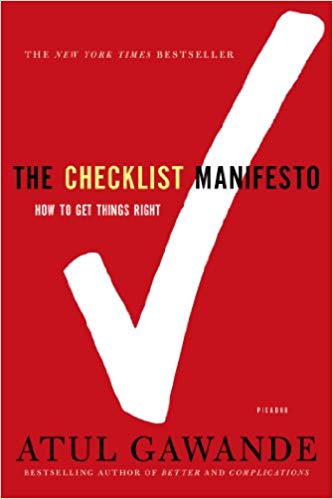

This article is an excerpt from the Shortform summary of "The Checklist Manifesto" by Atul Gawande. Shortform has the world's best summaries of books you should be reading.
Like this article? Sign up for a free trial here .
In medicine, the four vital signs (pulse, blood pressure, temperature, and respiration) have become an important regular check on how a patient is doing. Missing one can be dangerous. Would a medical checklist help make sure that each step was completed?
We’ll cover the benefits of medical checklists in a variety of medical fields and look at how they can significantly reduce complications and save lives.
Medical Checklists
Medical practitioners didn’t consistently measure and record the four vital signs until the 1960s, when nurses in Western hospitals designed patient charts that included them. Checking them off on a chart was a way of ensuring that in a busy and demanding environment, they wouldn’t forget to make the checks every six hours. Hospitals have since added a fifth vital sign, the patient’s pain level on a scale of one to ten.
In 2001, a critical care specialist at Johns Hopkins Hospital, Peter Pronovost, decided to try a medical checklist for doctors, targeting a common problem in ICUs: central line infections. A central line is a type of catheter placed in a large vein that allows multiple IV fluids to be given and blood to be drawn. Pronovost’s checklist listed the steps for avoiding infections:
- Wash your hands with soap.
- Clean the patient’s skin with antiseptic.
- Put a sterile drape over the patient.
- Wear a mask, hat, sterile gown, and gloves.
- Put a sterile dressing over the insertion line.
He asked nurses to watch doctors put lines in patients for a month and note and how often they carried out each step. More than a third of the time, doctors skipped at least one step. He then enlisted the hospital administration to authorize nurses to stop doctors if they skipped a step on the medical checklist.
Over a year, the line infection rate dropped from 11 percent to zero. Over 15 more months, there were only two line infections. Pronovost calculated that at just a single hospital, the medical checklist had prevented 43 infections and eight deaths and saved $2 million.
Building on the Success of the Medical Checklist
Pronovost tested more medical checklists in the Johns Hopkins ICU. For instance, his team created a checklist to ensure nurses checked patients for pain at least once every four hours and provided medication if necessary. The number of patients suffering untreated pain dropped from 41 percent to 3 percent.
They created another checklist for patients on mechanical ventilation or breathing assistance. Steps included making sure they received an antacid and propping up the head of the bed. The proportion of patients not receiving the specified care fell from 70 percent to 4 percent, incidence of pneumonias dropped by a quarter, and 21 fewer patients died than in the previous year.
Pronovost’s teams also found that care improved when they had doctors and nurses in the ICU create their own checklists for what should be done. The average length of stay in the ICU declined by half.
These medical checklists helped jog their memory and established the importance of basic steps, which even experienced staff had overlooked. They also set a higher standard for performance. For instance, before the ventilator checklist was implemented, half of the ICU staff hadn’t realized the importance of giving patients antacid medication.
Statewide Implementation of Medical Checklists
In 2003, Michigan Health and Hospital Association implemented Pronovost’s central line checklist throughout the state’s ICUs; it became known as the Keystone Initiative.
As part of the implementation process, each hospital assigned a senior hospital executive to hear staff concerns and help to solve problems. Executives learned that the right soap, shown to reduce line infections, wasn’t available in more than two-thirds of ICUs. They quickly provided the soap to all Michigan ICUs. Other important supplies that were often unavailable were provided as well.
In 2006, the Keystone Initiative published its findings in a landmark article in the New England Journal of Medicine. Within the first three months of using the medical checklist, the central line infection rate dropped by 66 percent. In terms of infection rates, the average ICU in Michigan did better than 90 percent of ICUs nationwide. In the first eighteen months, hospitals saved an estimated $175 million and more than 1,500 lives.
Miracle in Austria
Medical checklists have saved lives around the world. In 2001, a medical journal reported the recovery of a three-year-old girl who fell into an icy pond in a small town in Austria. It took her parents thirty minutes to find her, pull her out, and start CPR, while on the phone with EMTs. When rescue personnel arrived, they continued CPR and a helicopter got her to a small hospital, where staff put her on a heart-lung bypass machine and took her directly to the OR. At the two-hour mark, her heart began to beat and in six hours her temperature, which had been 66, reached normal. She had lung damage and brain swelling, but was able to go home in two weeks. She completely recovered by age 5.
The medical staff had pulled off something hugely complicated. Dozens of people had to carry out many steps correctly and in the right order. Usually, patients in such cases don’t survive. The hospital had previously lost drowning victims and had devised a new system in hopes of saving lives in the future.
They succeeded with the help of a medical checklist. Under the leadership of the cardiac surgeon, they had made a checklist, designating key roles for the rescue squads and the hospital telephone operator. For instance, rescue teams were to alert the hospital to prepare for a possible cardiac bypass before they even arrived on the rescue scene to allow preparation to get underway. The telephone operator would then notify a list of people to have everything set up. With the medical checklist in place, the team’s first success was the rescue of the little girl. Two other such rescues followed.
Ineptitude in Action
Surgeons like Gawande often tell each other stories of mistakes and near misses, puzzling over how they could have missed seeing something that turned out to be vital. For instance, a surgeon friend told Gawande s story about treating a drunken patient with a stab wound received at a Halloween costume party. The emergency department determined the two-inch-wide abdominal wound wasn’t an extreme injury although he needed surgery, so they parked the patient while the operating room was readied.
Then a nurse noticed his condition was deteriorating. They began life-saving measures and rushed him immediately to the operating room, where they discovered that the man’s stab wound went 12 inches into his body, right into the aorta. With great effort, they managed to save him.
In the process of assessing the patient, the team had gotten almost everything right, but they’d forgotten to ask what he’d been stabbed with, which would have indicated the severity of the injury. A party-goer dressed as a soldier had stabbed him with a bayonet.
In another case, the same surgeon was removing a cancer of the stomach when, about halfway through the procedure, the patient’s heart stopped. The team couldn’t find any cause as they worked to resuscitate him and called for additional personnel and equipment. A senior anesthesiologist who’d been in the room earlier, before the patient had been put to sleep, arrived to help. He asked the attending anesthesiologist if he’d done anything additional since they’d last spoken. The doctor said yes, he’d given the patient potassium when lab reports arrived showing his levels were too low.
When the team dug the IV bag out of the trash, they discovered that the patient had been given the wrong concentration — a lethal dose. Through a variety of heroics, they managed to bring him back. The team was shaken: they’d had all the necessary knowledge and tools, but their ineptitude nearly killed him. Would a medical checklist have helped?
An Explosion of Knowledge and Complexity
In trying to do the right things, the challenge of the 21st century is ineptitude, rather than ignorance. It used to be the reverse. For most of human history, we struggled with scientific ignorance. We didn’t understand how things worked or what caused illnesses and how to treat them.
For instance, doctors didn’t know how to treat heart attacks or how to prevent them as recently as the 1950s. Patients were prescribed morphine and bed rest and, if they survived, they lived as invalids. Today, however, we have a host of treatments and procedures that save lives and limit heart damage. Also, we can prevent many heart attacks because we understand and can mitigate the risks of high blood pressure, cholesterol, smoking, and diabetes.
But while science has increased our knowledge dramatically, we still often fail. The reason isn’t lack of money, malpractice, or government or insurance issues. It’s the enormous and ever-increasing complexity of many fields today. We struggle to apply knowledge the right way at the right moment. Under pressure, we make simple mistakes and overlook the obvious.
For instance, authorities at all levels make numerous mistakes when disasters strike. Attorneys make mistakes in complex legal cases, most commonly administrative errors. We have foreign intelligence failures, cascading banking industry failures, and software design flaws that compromise the personal information of millions of people. Deciding the right treatment among the many options for a heart attack patient can be extremely difficult. Each one involves complexities and pitfalls.
Getting the right thing done is a challenge too. From research, we know that heart attack patients who will benefit from cardiac balloon therapy should have it within 90 minutes of arriving at a hospital. After that, survival rates drop. But a 2006 study showed less than a 50 percent likelihood that a medical staff could get everything done that needed to be done in less than 90 minutes. Similarly, at least 30 percent of stroke patients get insufficient care, and the same is true for 45 percent of asthma patients and 60 percent of pneumonia patients. Knowing the right steps and trying hard aren’t enough.
A Different Strategy
Those on the receiving end of such failures naturally react with outrage. We can forgive ignorance and accept that others tried their best with what they knew. But when the experts know what to do and fail to do it, we’re likely to blame gross negligence, incompetence, or heartlessness. This ignores the complexity of many jobs today.
The problem is that across numerous professions — medicine, engineering, finance, business, government — the level and complexity of our knowledge is more than any individual can apply correctly in all circumstances. Knowledge has saved and also overwhelmed us.
Most professions, especially medicine, have traditionally responded to failure by requiring more training and experience. Training of medical personnel, police, engineers, and others is more extensive than ever. Due to increased training requirements, doctors don’t practice independently until their mid-thirties. But while training and experience are important, expertise doesn’t address human fallibility. We need a different strategy for preventing failure that takes advantage of knowledge and experience but also compensates for human flaws.
The solution is a simple medical checklist.
Saved by a Medical Checklist
In 2007 as soon as the Safe Surgery Checklist took shape, Gawande began using it in his surgeries. Hardly a week went by without the medical checklist enabling the team to catch something they would have otherwise missed.
For instance, in one week, there were catches in five cases, including:
- A patient hadn’t gotten the antibiotic she should have.
- The surgeon learned of a breathing risk at the last minute.
- The team discovered drug allergies, equipment problems, confusion about medications, and labeling mistakes.
In another case, the checklist saved the patient’s life. Gawande was performing surgery to remove a man’s adrenal gland because of a tumor. He made a catastrophic tear, resulting in massive bleeding and cardiac arrest. But due to the medical checklist, four units of the right blood were available and ready to go — this step saved the patient’s life. In addition, staff members were prepared to work as a team and everyone stayed calm and did what was needed. Although he had a long recovery, the patient survived.
———End of Preview———

Like what you just read? Read the rest of the world's best summary of "The Checklist Manifesto" at Shortform . Learn the book's critical concepts in 20 minutes or less .
Here's what you'll find in our full The Checklist Manifesto summary :
- How checklists save millions of lives in healthcare and flights
- The two types of checklists that matter
- How to create your own revolutionary checklist






